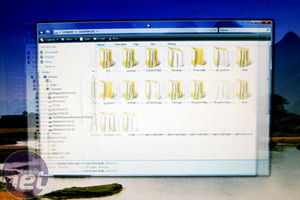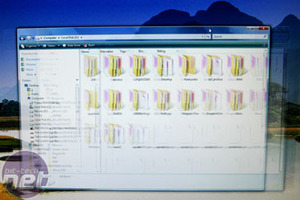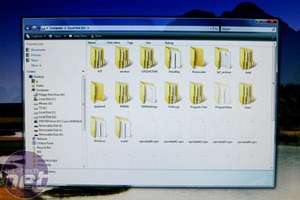
Inverse ghosting
While input lag appears exclusive to PVA and MVA panels, there’s another more widespread overdrive-related issue that extends to TN screens, too.In simple terms, inverse ghosting involves a trail or shadow that appears in the wake of a moving object in approximately the opposite colour to that object – hence the term inverse. It is not, therefore, the blurry, smeared trail seen on monitors with poor pixel response. In practice, you might see a dark, well defined shadow trailing behind a bright object and vice versa.
The precise manner in which it manifests varies widely and depends upon the colour of both the object and the background it is passing over as well as the panel type and strength of overdrive.
A good example of inverse ghosting is provided by Viewsonic's new VX2260WM, a 1080p 22-inch monitor with a TN panel. Handily, Viewsonic has given the VX2260WM a response time toggle in the OSD menu with three options – Standard, Advanced and Ultra Fast. The Ultra Fast option uses a particularly aggressive form of pixel overdrive and the results can be seen below.
The first image shows an Explorer window being jostled back and forth on the desktop in one of the Viewsonic’s standard mode. Note in particular the colours of the folders. Then look at the second image, captured with the VX2260WM in Ultra Fast mode. Suddenly, the moving folders are shadowed by extremely odd-looking pink artefacts.
It’s hard to say exactly how widespread this problem is. It may affect all overdriven panels to some degree. Often it’s extremely hard to detect and only appears with objects of a very particular colour.
As with input lag, thanks to the unwillingness of monitor makers to discuss overdrive related problems, we can’t say exactly what is going on. It’s safe to say that it is related to the exaggerated voltages inherent to overdrive implementations and an educated guess would say it boils down to pixels overshooting their target colour states.
Ultimately, only the very worst examples of inverse ghosting noticeably degrade image quality. However, at the very least, its existence should make you wary of buying a monitor based mainly on exotically low pixel response performance. Odds are, aggressive overdrive is responsible.
To an extent, the same applies to input lag. Only the very laggiest panels will be unacceptable to most users. However, we still feel it pays to be wary of PVA panels with very low pixel response performance. Don't let the monitor makers seduce you with showbiz performance claims. Tireless technological refinement has ironed out most of the really serious flaws suffered by early LCD monitors, but there’s still no such thing as a perfect panel.

MSI MPG Velox 100R Chassis Review
October 14 2021 | 15:04











Want to comment? Please log in.